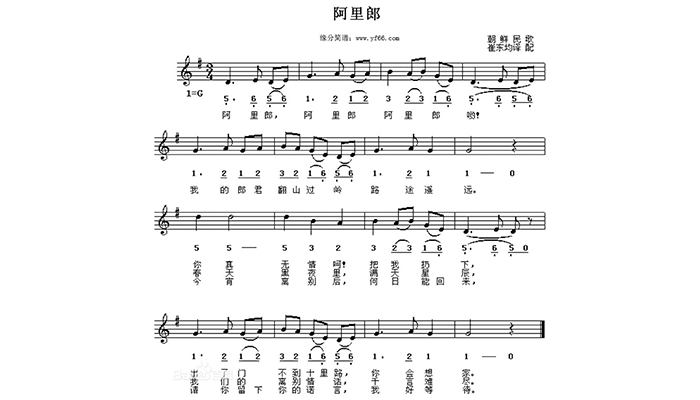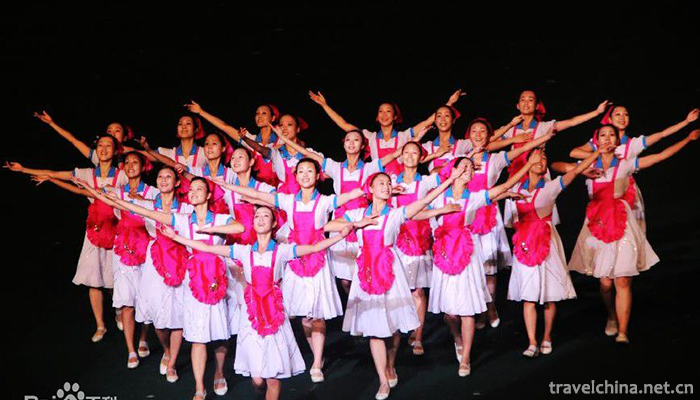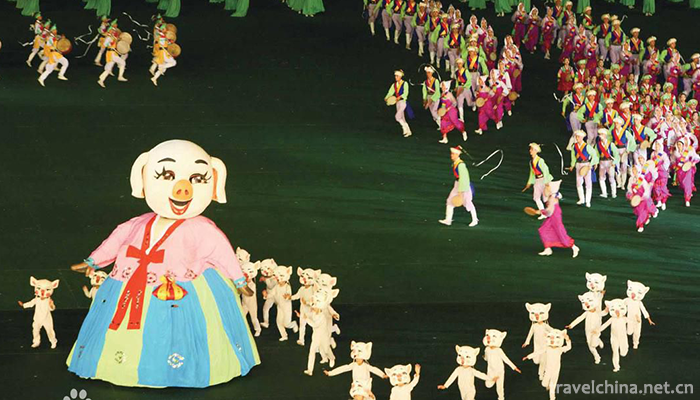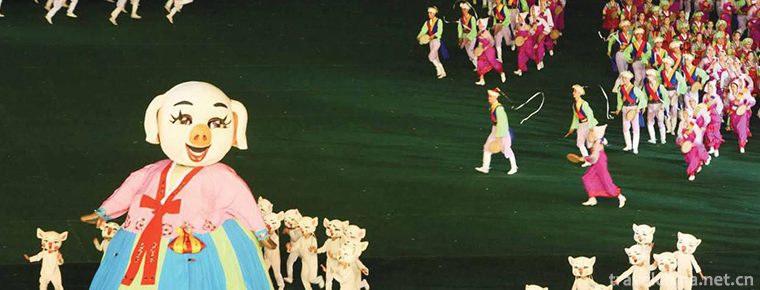Arirang
Arirang
Alirang, known as Alirang Daling, is a famous Korean song and the most representative folk song on the Korean Peninsula. It is known as the "First National Anthem" and "National Songs" of the Korean nation. It has different versions in different places, and the most common one is "Arirang in this tune", which is popular in the area of Gyeonggi Dao, Korea. This version is popular because it became the theme song of the 1926 film of the same name. It was later used as a live music for delegations of the Republic of Korea and the Democratic People's Republic of Korea during the 2000 Sydney Olympics.
In June 2011, Alirang was included in the national intangible cultural heritage list of the People's Republic of China.
At the seventh meeting of the Intergovernmental Committee for the Protection of Intangible Cultural Heritage, held in Paris on 5 December 2012, UNESCO decided to include Arirang in the list of intangible cultural heritage of mankind.
Background of songs
Song story
Arirang is a love story handed down from the Koryo period.
Perhaps the plot is a loving young couple, living a hard life, the husband wants his wife to live a good life, want to go out to work to earn money, but the wife refused to let, said that as long as they stay together she would be satisfied, but the husband did not think so, one night quietly left. The wife is very beautiful, and all the villages are famous. After her husband left, the ruffians in the village harassed her and asked her to remarry. She refused, but the ruffians always harassed her. A year later, the husband came back from earning money. The husband and wife were happy. The ruffians came again. There was also gossip about wives and ruffians in the village. The husband became suspicious and thought that his wife was not faithful and would leave again. The wife could not explain it. The husband left. The wife chased after him and sang when she couldn't catch up with him. The content of the song is probably about how the husband cares about, misses, wrongs and so on. My wife sang this passage is "My Langjun", that is, Arirang, and finally her sincerity melted the husband's cold heart, the couple love as before, they left their hometown to live a happy life in the capital. Later, the story and song of Ali Lang spread and became a representative classic music card of the Korean nation. No matter where in the world, as long as there are Korean people, Ali Lang will be known as the Korean nationality by singing Ali Lang.
During the period of Japanese rule, the Koreans launched an uprising under the name of Alirang. The Japanese found out that whoever sang Alirang would kill him. But killing ten people to sing, killing ten hundred people to sing, killing a hundred thousand people to sing again, the more they sing, the Japanese have to stop.
Textual research
The origin of Alirang Opera is said to be Yan Ying, the wife of Pak He, the ancestor of New Luo, who lived in the world and was renamed "Alirang". It was created by the native Qude. Or the Alirang tune, which is imitated after playing the Korean flute for a long time. Among them, the legend of Mercy Hill is more trustworthy.
The Mercy Ridge (now known as Qiling, in Huanghai Hokkaido, Huangzhou, Korea Peninsula) exists on the map of the Korean Peninsula today. When Emperor Wudi of Han Dynasty set up four counties on the Korean Peninsula, the northern nationalities of the mainland began to migrate across the river because of oppression. These emigrants who have left their homeland are lamenting in Ciling, Guanzhi, North Passage. Many old and weak women and children are dying of illness. In this exile, Ali Lang Qu spread to the middle of the Korean Peninsula, expressing the pain of immigrants'hearts, after climbing mountains and crossing mountains, Ali Lang Qu was spread to the middle of the Korean Peninsula. Historians believe that these foreign nationalities regarded by the Han people as Dongyi are ancient Korean nationalities, and Arirang is the onomatopoeia of the Korean ancient language "Lelang".
There is also a widely circulated saying that "Alirang" means "I am deaf". In the 19th century, the emperor of Xingxuan Grand Court was in power, and civil engineering was greatly promoted to rebuild Jingfu Palace. In order to rebuild this luxurious palace, the Court seized and plundered from the people, imposed heavy taxes such as "willing to pay money" and forced corvee, so that the whole Korean people were not bored. People say angrily, "It's better to be deaf than deaf. It's quiet to be deaf!" Thus, the civilian husband who was dragged to serve compiled the ballad "My Deafness", expressing the sadness in his heart, and later evolved into "Alirang". It is also said that the background is the reign of the monarch of the courtyard and the restoration of Jingfu Palace, but the difference is that Arirang originated from "I left my mother", which is the ballad of the people who were dragged to rebuild Jingfu Palace missing their mother.
There are many versions of Arirang, whose lyrics vary slightly according to different places in the Korean Peninsula. But in Korean, Arirang is not a person's name, but a place name. Some people think it's a mountain's name, but they can't prove where it is. Alilangqu in different places, though not the same, shows the perseverance and perseverance of ancient women.
Song appreciation
This "Arirang" narrates a Korean girl's yearning for her husband and her desire for love. The melody is euphemistic and lyrical, and the rhythm is light and smooth. The whole song is composed of two phrases, the upper and the lower, and repeats with changes. It is composed of double sentences with a chorus. "Arirang" is a 3/4 beat, sub-tone palace-style melody. Mood slightly sad, is a representative Korean folk song.
The folk song "Arirang" is divided into two parts, the melody of which often takes the form of surround but little big jump, and is a common progressive way, reflecting the repetition and reproduction of rhythm, showing the dignity, elegance and delicacy of Korean folk songs. But Korean folk songs are full of passion. That is the five-degree upward jump and rhythmic transformation between the eight and nine sub-sections, forming the climax of the whole song. After two bars, it goes down continuously until the lowest tone of the whole tune, and the first part of the first part of the tune appears. Make music calm and implicit after an exciting and brief catharsis. This is a folk song (a, a1) in which two big phrases change and repeat.
Pass through
Arirang is a popular song on the Korean Peninsula. It was gradually popular in the late Korean Dynasty, but it was generally defined as "gorgeous song" or "barren sound" by the society, and its status is not very high, especially for Confucian scholar-bureaucrats. Historically, Gaozong of Korea liked to listen to Alirang very much, playing it to him every night in the palace. There are more than 30 versions of Alirang on the Korean Peninsula. In addition to Peishan Alirang, Yongchuan Alirang, Miyang Alirang, Zhendao Alirang, Gaocheng Alirang, Jiangnan Alirang, Duanchuan Alirang, Ping'an Alirang and so on, among which Peishan Alirang is the most popular. For its fame, it ranks second only to Alirang in this tune. In the period of Japanese colonial rule (1910-1945), especially after the film "Alirang" produced by Luo Yunkui came out in 1926, Alirang began to be valued as a Korean folk song and gradually finalized. So far, Arirang bears the national consciousness of the Korean nation and is praised as the "first national anthem" and "national song" of the Korean nation.
In modern times, "Arirang" began to be displayed on the international stage as a brand image of the Korean nation. The Democratic People's Republic of Korea (DPRK/DPRK) holds the "Arirang Festival" every year to show the national image of DPRK (DPRK/DPRK) through the large-scale artistic performance "Arirang".
Song influence
At the 2000 Sydney Olympic Games, Arirang became the entrance music for the delegations of the Democratic People's Republic of Korea and the Republic of Korea to enter the stadium together.
In June 2011, the State Council of the People's Republic of China designated Alirang as the national intangible cultural heritage.
On December 5, 2012, UNESCO included the Korean traditional ballad Arirang in the list of intangible cultural heritage of mankind.
On July 14, 2015, the Korea Cultural Finance Department said that in order to designate the ballad "Arirang" as an important intangible cultural heritage, the Department began to seek advice from the community.
On February 9, 2018, the Korean and Korean delegations of the 23rd Pyongchang Winter Olympic Games jointly entered the venue, where the Korean folk song "Arirang" was sounded.




-
1.Yongquan Qicheng Great Wall Ecological Scenic Area
The Great Wall of Yongquan Qi is a quiet tourist scenic spot, located in Yongquan Village, Zihe Town, Zibo City, where Pu Songling lived in the southeast mountain area. Here the mountains are connecte
Time 2019-03-05 -
2.Dai Medicine Sleeping Drug Therapy
Sleeping pill therapy, one of the ten traditional Dai medicine therapies, is the third batch of national cultural heritage in Yunnan.
Time 2019-04-24 -
3.Jingshan tea banquet
Jingshan Tea Banquet, born in the Longevity Chan Temple of Jingshan, Jingshan Town, Yuhang District, began in Tang Dynasty and flourished in Song Dynasty. It has a history of more than 1200 years
Time 2019-05-08 -
4.Liao Zhais folk songs
The spreading area of Liaozhai slang mainly distributes in Zibo City, Shandong Province. The Pu family and its descendants are the main inheritors. Liaozhai slang is a unique traditional folk music li
Time 2019-05-13 -
5.Lv Opera
Lv Opera, also known as masqueraded Yangqin and Qinxi Opera, National intangible cultural heritage, one of the eight major Chinese operas, Shandong's most representative local operas, is popular in mo
Time 2019-05-15 -
6.Zhulang Niangmei
Zhulang Niangmei is a work of Dong Opera in Guizhou Province. At the end of the Qing Dynasty, Liang Yaoting and Liang Shaohua, Dong opera masters in Congjiang County, Guizhou Province, adapted Dong dr
Time 2019-08-10 -
7.Yuchan mountain
Yuchan mountain is located next to Luxian County, Luzhou City, Sichuan Province. It is named for its mountain shape and stone like shape. Yuchan mountain has always been famous in South Sichuan for its secluded mountains, strange stones, beautiful waters and many cultural relics.
Time 2020-10-15 -
8.Hanging coffin of Bo people BoRen
"Bo People's hanging coffin" is located in Yibin City, Sichuan Province. It is distributed in Gongxian County, Xingwen County and Junlian county. "Gong county annals" records that "Gongben Bo land, Bo people hanging coffins.".
Time 2020-10-16 -
9.Taoping Qiang Village
Taoping Qiang village is located in Taoping Township, beside Zagunao River in Lixian County. Qiang village is 40 km away from Lixian City, 16 km from Wenchuan city and 139 km from Chengdu. It is a national key cultural relics protection unit and an important scenic spot in Jiuhuang line tourism circle.
Time 2020-11-07 -
10.Notice for visiting Chengdu Giant Panda Base
Please don't make any noise. Don't make any abnormal or sharp sounds, which will disturb the wild animals. Giant pandas and other animals naturally like quiet environment and are sensitive to noise. In order to ensure the effect of your visit, please respect their living habits and keep a quiet environment.
Time 2020-12-13 -
11.Topography and geomorphology of Luzhou
Luzhou city is a typical mountainous city with 56.14% of the total land area. It is mainly composed of high mountains (500-1000 meters above sea level) and middle mountain (1000-1902 meters above sea level). Taking the middle Yangtze River Valley as the lowest center, it gradually
Time 2020-12-14 -
12.Luzhou local culture
Luzhou cuisine is a branch of three main local flavor schools in Modern Sichuan cuisine. In June 2018, Luzhou City released four local standards for "Luzhou cuisine", namely, Douban tuoyu, dry roasted carp, Luzhou pickled sea pepper and Luzhou pickled ginger, marking that Luzhou has its own standard for "Luzhou cuisine".
Time 2020-12-14